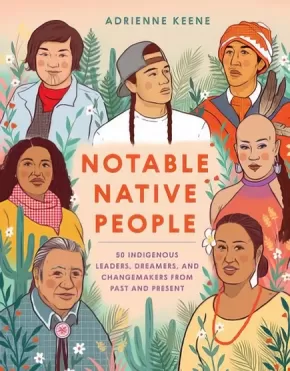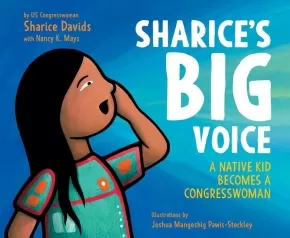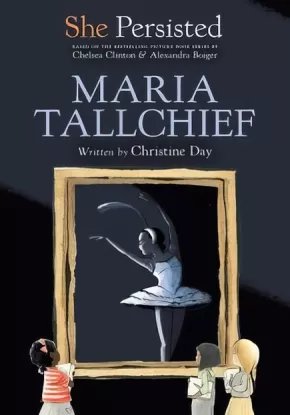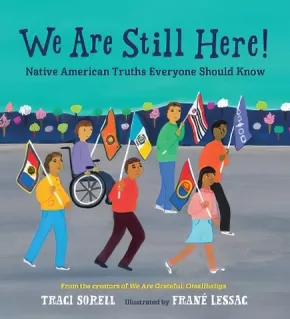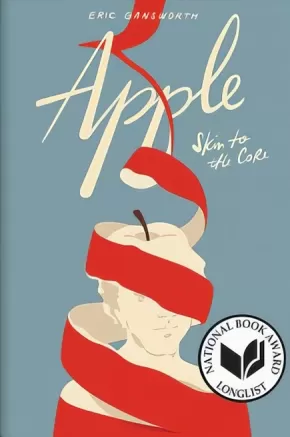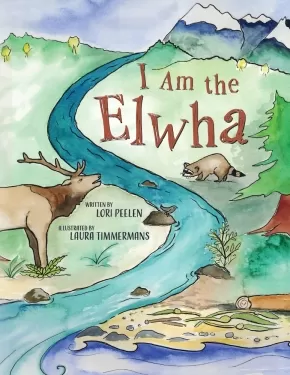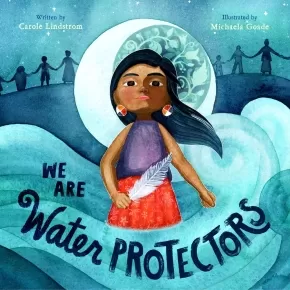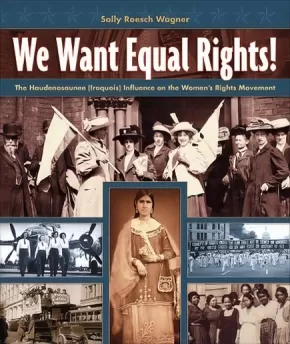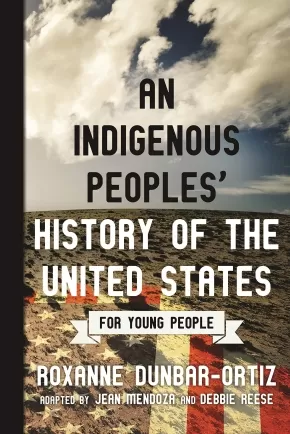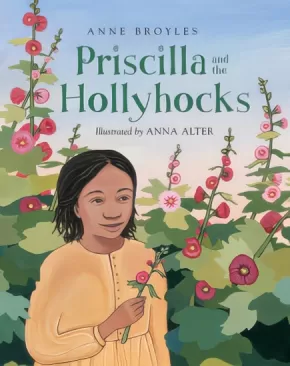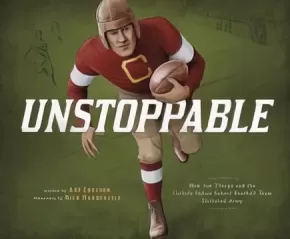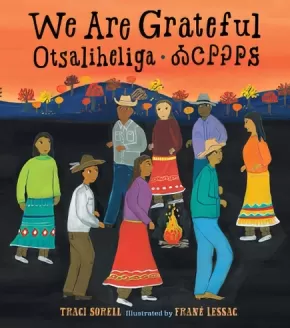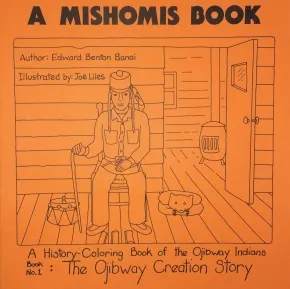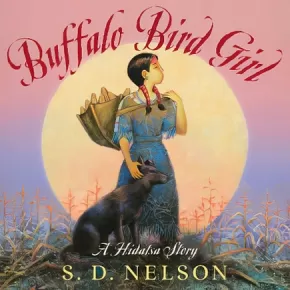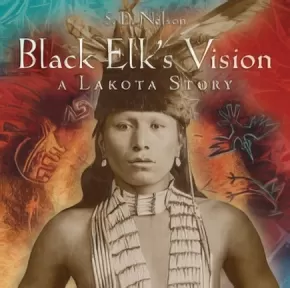
Native American
61
-
75
of
80 Results;
Sort By
Go To
of 6
Notable Native People: 50 Indigenous Leaders, Dreamers, and Changemakers from Past and Present
$24.99
Artists:
Format:
Hardcover
Text Content Territories:
Indigenous American; Alaska Native; Native American; Indigenous Hawaiian;
ISBN / Barcode: 9781984857941
Synopsis:
Synopsis:
An accessible and educational illustrated book profiling 50 notable American Indian, Alaska Native, and Native Hawaiian people, from NBA star Kyrie Irving of the Standing Rock Lakota to Wilma Mankiller, the first female principal chief of the Cherokee Nation
Celebrate the lives, stories, and contributions of Indigenous artists, activists, scientists, athletes, and other changemakers in this beautifully illustrated collection. From luminaries of the past, like nineteenth-century sculptor Edmonia Lewis—the first Black and Native American female artist to achieve international fame—to contemporary figures like linguist jessie little doe baird, who revived the Wampanoag language, Notable Native People highlights the vital impact Indigenous dreamers and leaders have made on the world.
This powerful and informative collection also offers accessible primers on important Indigenous issues, from the legacy of colonialism and cultural appropriation to food sovereignty, land and water rights, and more. An indispensable read for people of all backgrounds seeking to learn about Native American heritage, histories, and cultures, Notable Native People will educate and inspire readers of all ages.
Additional Information
144 pages | 7.26" x 9.29" | Hardcover
Sharice's Big Voice: A Native Kid Becomes a Congresswoman
$21.99
Format:
Hardcover
ISBN / Barcode: 9780062979667
Synopsis:
Synopsis:
This picture book autobiography tells the triumphant story of Sharice Davids, one of the first Native American women elected to Congress, and the first LGBTQ congressperson to represent Kansas.
When Sharice Davids was young, she never thought she’d be in Congress. And she never thought she’d be one of the first Native American women in Congress. During her campaign, she heard from a lot of doubters. They said she couldn’t win because of how she looked, who she loved, and where she came from. But here’s the thing: Everyone’s path looks different and everyone’s path has obstacles. And this is the remarkable story of Sharice Davids’ path to Congress.
Beautifully illustrated by Joshua Mangeshig Pawis-Steckley, an Ojibwe Woodland artist, this powerful autobiographical picture book teaches readers to use their big voice and that everyone deserves to be seen—and heard!
Educator Information
Recommended ages 4 to 8.
The back matter includes information about the Ho-Chunk written by former Ho-Chunk President Jon Greendeer, an artist note, and an inspiring letter to children from Sharice Davids.
Additional Information
40 pages | 11.00" x 9.00"
She Persisted: Maria Tallchief
$9.50
Format:
Paperback
Text Content Territories:
Indigenous American; Native American; Osage;
ISBN / Barcode: 9780593115817
Synopsis:
Synopsis:
In this chapter book biography by award-winning author Christine Day, readers learn about the amazing life of Maria Tallchief--and how she persisted.
Maria Tallchief loved to dance, but was told that she might need to change her Osage name to one that sounded more Russian to make it as a professional ballerina. She refused, and worked hard at dancing her best, becoming America's first prima ballerina. Many famous American ballets were created for Maria!
Complete with an introduction from Chelsea Clinton, black-and-white illustrations throughout, and a list of ways that readers can follow in Maria Tallchief's footsteps and make a difference!
Reviews
"A rich, clear picture of how one iconic Native dancer persisted." --Publishers Weekly
"Inspiringly shows how Maria Tallchief persisted and made her dreams come true." --Kirkus Reviews
Educator & Series Information
Recommended for ages 6 to 9.
This book is part of the She Persisted series, a chapter book series about women who spoke up and rose up against the odds.
Additional Information
80 pages | 5.38" x 7.69" | Paperback
We Are Still Here!: Native American Truths Everyone Should Know
$21.99
Artists:
Format:
Hardcover
Text Content Territories:
Indigenous American; Native American;
ISBN / Barcode: 9781623541927
Synopsis:
Synopsis:
Twelve Native American kids present historical and contemporary laws, policies, struggles, and victories in Native life, each with a powerful refrain: We are still here!
Too often, Native American history is treated as a finished chapter instead of relevant and ongoing. This companion book to the award-winning We Are Grateful: Otsaliheliga offers readers everything they never learned in school about Native American people's past, present, and future. Precise, lyrical writing presents topics including: forced assimilation (such as boarding schools), land allotment and Native tribal reorganization, termination (the US government not recognizing tribes as nations), Native urban relocation (from reservations), self-determination (tribal self-empowerment), Native civil rights, the Indian Child Welfare Act (ICWA), religious freedom, economic development (including casino development), Native language revival efforts, cultural persistence, and nationhood.
Reviews
"Students at the Native Nations Community School share presentations about the history, present, and future of Indigenous communities. The vivid artwork features a simple, bold style. The narrative starts with a general introduction of Native Nations in the United States. Each presentation contains illustrations with the student’s name, an overview of the subject, a brief list of the impact that the concept or historical moment had on Native American people, and the refrain “We Are Still Here!” The last pages show students and their families with a variety of skin tones and physical abilities studying the presentations on topics that include sovereign rights and relocation. Additional information, a timeline, a glossary, sources, and an author’s note offer further context. The lyrical text and jewel-tone illustrations elegantly work together to stirringly portray the ongoing fight for Native American recognition and rights. VERDICT An essential purchase for introducing the impact laws and treaties had and continue to have on Native Nations." —School Library Journal, starred review
"In this meticulously researched nonfiction picture book, Sibert honorees Sorell and Lessac team up once again to answer this question: What has happened to Native Nations and their citizens after the treaties with the U.S. government ended in 1871? Lessac’s trademark colorful, folk-art–style illustrations show a Native American community school with a classroom of diverse students preparing for presentations at the Indigenous People’s Day assembly. Spread by spread, each child speaks, featured words and terms highlighting the journey Native Nations have taken to reclaim their land and rights. They show why Indigenous people say, “We are still here!” In the “Assimilation” presentation, Native children are dressed in militarylike uniforms, showing how U.S. leaders used schooling to destroy Native traditions. Dividing plots of tribal land for “Allottment” left much treaty land open for public sale. With “Termination” and “Relocation,” Native people were encouraged to leave their tribal lands and “act more like white people.” But Indigenous people say, “We are still here!” and the narrative arc turns to emphasize resilience. When activists speak up and organize, it strengthens tribal sovereignty. The tribes “protect and provide for future generations” by holding on to their traditional ceremonies, opening businesses to support their tribal members, and reviving their tribal languages. The illustrations, too, change their tenor, modulating from historical wrongs to emphasize contemporary strength, community, and joy. An emphatic, triumphant declaration: “WE ARE STILL HERE!”" —Kirkus Reviews, starred review
Educator Information
Recommended for ages 7 to 10.
This book has a Native American focus.
Additional Information
40 pages | 9.88" x 10.81"
Apple (Skin to the Core)
$28.99
Format:
Hardcover
Text Content Territories:
Indigenous American; Native American; Haudenosaunee (Iroquois); Onondaga;
ISBN / Barcode: 9781646140138
Synopsis:
Synopsis:
How about a book that makes you barge into your boss's office to read a page of poetry from? That you dream of? That every movie, song, book, moment that follows continues to evoke in some way?
The term "Apple" is a slur in Native communities across the country. It's for someone supposedly "red on the outside, white on the inside."
Eric Gansworth is telling his story in Apple (Skin to the Core). The story of his family, of Onondaga among Tuscaroras, of Native folks everywhere. From the horrible legacy of the government boarding schools, to a boy watching his siblings leave and return and leave again, to a young man fighting to be an artist who balances multiple worlds.
Eric shatters that slur and reclaims it in verse and prose and imagery that truly lives up to the word heartbreaking.
Awards
- American Indian Youth Literature Award Winner
Reviews
"With language rich in metaphor, this is a timely and important work that begs for multiple readings."-Booklist, starred review
Educator Information
Recommended for ages 12 to 18.
Additional Information
352 pages | 6.50" x 9.40"
I Am the Elwha (HC)
 $18.50
$18.50

Artists:
Format:
Hardcover
Text Content Territories:
Indigenous American; Native American; Salish; Coast Salish; Klallam (Clallam); Lower Elwha Klallam Tribe;
ISBN / Barcode: 9781771744744
Synopsis:
Synopsis:
“I am the Elwha, rushing down to the sea. I am the Elwha, wild and free.”
The Elwha River flows 72 kilometres (45 miles) from its source in the Olympic Mountains to the Strait of Juan de Fuca in the Pacific Northwest. Uniquely, it hosts all six salmon species (Pink, Chinook, Coho, Sockeye, Steelhead, and Chum) as well as several species of trout.
In 1911 two dams were built on the river. The dams blocked the migration routes of the salmon and dramatically altered the entire river ecosystem for 100 years. In 2012 the dams were decommissioned and the world’s largest dam removal and habitat restoration project began.
In this lyrical and beautifully illustrated book, the author chronicles the history of the Elwha. Narrated by the powerful voices of plants and animals that inhabit the river ecosystem, the dam builder, a worker, and the river itself, this story celebrates the ongoing rewilding of this special environment and offers a welcome to all of the creatures who are coming home.
To learn more visit: www.elwha.org
Awards
- 2021 Riverby Award for Young Readers
Reviews
“I Am the Elwha is a powerful read about a powerful river and those who value and protect it." – Raina Delisle, Hakai Magazine
Educator Information
At the back of the book are three pages of cultural, scientific, and historical information that discuss the following:
- the importance and symbolism of salmon to the Lower Elwha Klallam Tribe and other Coastal Salish Tribes
- facts about the six species of salmon found in the Elwha River (Chinook, Pink, Chum, Sockeye, Coho, and Steelhead)
- the history of the Elwha River and its status today
Keywords / Subjects: The Elwha River, Rivers, Dams, History, Environmental Awareness, Lower Elwha Klallam Tribe, Coast Salish, Native American, Culture, Washington, Animals, Salmon, First Salmon Ceremony, Plants, Nature, Settlers, Social Responsibility, Environmental Activism, Poetry.
Recommended for grades 3 to 7.
Additional Information
32 Pages | 8.5" x 11" | ISBN: 9781771744744 | Hardcover
Authenticity Note: This lyrical story, which chronicles the history of the Elwha River, is written by Lori Peelen. Robert Elofson, Tribal Elder and Harvest Manager in the Natural Resources Department for the Lower Elwha Klallam Tribes, approved Lori's work and contributed a few pages of back matter at the end of the work. Lori's story was further approved by Frances Charles, the Tribal Councilwoman for the Lower Elwha Klallam Tribe, after the entire council read and approved it.
The Canadian Content label has been applied because the illustrator of this work is Canadian.
We Are Water Protectors
$24.99
Artists:
Format:
Hardcover
Text Content Territories:
Indigenous Canadian; First Nations; Anishinaabeg; Indigenous American; Native American; Anishinaabeg;
ISBN / Barcode: 9781250203557
Synopsis:
Synopsis:
Inspired by the many Indigenous-led movements across North America, Carole Lindstrom's bold and lyrical picture book We Are Water Protectors issues an urgent rallying cry to safeguarding the Earth’s water from harm and corruption.
Water is the first medicine.
It affects and connects us all . . .
When a black snake threatens to destroy the Earth and poison her people’s water, one young water protector takes a stand to defend Earth’s most sacred resource.
Featuring illustrations by Michaela Goade.
Educator Information
Recommended for ages 3 to 6.
Includes information on water protectors and the importance of water protection at the back of the book, as well as a glossary with a few words in different Indigenous languages, such as Ojibwe, Tlingit, and Lakota.
This book is available in French: Nous sommes les protecteurs de l'eau
Additional Information
40 pages | 10.00" x 10.00"
We Want Equal Rights!: How Suffragists Were Influenced by Haudenosaunee Women
$18.95
Format:
Paperback
Text Content Territories:
Indigenous American; Native American; Haudenosaunee (Iroquois);
ISBN / Barcode: 9781939053282
Synopsis:
Synopsis:
This is the story of remarkable women who laid the foundation for the modern women's movement and the Native American nation that proved equality was possible. In 1850, these brave women challenged a culture that believed they were inferior to men. How did they envision such a world? They looked to their neighbors the Haudenosaunee (Iroquois) and saw how women were held in high regard, with even greater rights than men. In the United States, a woman was considered subservient to her husband, who gained all his wife's wealth upon marriage. Women had no claim to their children and were considered runaway slaves if they left an abusive man. In contrast Haudenosaunee society provided a shining example of what is possible when women are treated with respect. Read how early activists forged a path to women's equal rights using the ideals of their Native American neighbors.
Educator Information
Recommended for ages 9 to 12.
This work is from an American publisher. Therefore, terminology may be different than what is used in Canada.
Subjects / Concepts: Human Rights, Women's Rights, Native American, Indigenous, History, Biographies, Social Activists.
Additional Information
48 pages | 7.90" x 9.40" | Paperback
An Indigenous Peoples' History of the United States for Young People
$24.95
Format:
Paperback
Text Content Territories:
Indigenous American; Native American;
ISBN / Barcode: 9780807049396
Synopsis:
Synopsis:
Spanning more than 400 years, this classic bottom-up history examines the legacy of Indigenous peoples’ resistance, resilience, and steadfast fight against imperialism.
Going beyond the story of America as a country “discovered” by a few brave men in the “New World,” Indigenous human rights advocate Roxanne Dunbar-Ortiz reveals the roles that settler colonialism and policies of American Indian genocide played in forming our national identity.
The original academic text is fully adapted by renowned curriculum experts Debbie Reese and Jean Mendoza, for middle-grade and young adult readers to include discussion topics, archival images, original maps, recommendations for further reading, and other materials to encourage students, teachers, and general readers to think critically about their own place in history.
Reviews
“An important corrective to conventional narratives of our nation’s history . . . . An accessible, engaging, and necessary addition to school libraries and classrooms. An excellent read, dismantling American mythologies and fostering critical reasoning about history and current events.” —Kirkus Reviews, Starred Review
“This adaptation of An Indigenous Peoples’ History of the United States (2014) should be required reading for all middle and high schoolers—and their teachers . . . . There is much to commend here: the lack of sugar-coating, the debunking of origin stories, the linking between ideology and actions, the well-placed connections between events past and present, the quotes from British colonizers and American presidents that leave no doubt as to their violent intentions . . . . The resistance continues, and this book urges all readers to consider their own roles, whether as bystanders or upstanders.” —Booklist, Starred Review
“Dunbar-Ortiz’s narrative history is clear, and the adapters give readers ample evidence and perspective to help them to engage with the text. A highly informative book for libraries serving high school students.”—School Library Journal, Starred Review
“This is the book I wish I’d had when I started teaching. An Indigenous Peoples’ History of the United States for Young People represents a fundamental challenge to the textbooks that celebrate ‘liberty,’ ‘freedom,’ and the ‘rise of the American nation’ but fail to recognize the humanity—or often even the existence—of the Indigenous peoples who were here first, and are still here. Our students will see the history of this country much more clearly when we put Indigenous people’s lives at the center.” —Bill Bigelow, curriculum editor, Rethinking Schools, and codirector, Zinn Education Project
Educator Information
Recommended for ages 12+
Additional Information
272 pages | 5.49" x 7.97"
Priscilla and the Hollyhocks
$9.99
Artists:
Format:
Paperback
Text Content Territories:
Indigenous American; Native American; Cherokee;
ISBN / Barcode: 9781570916762
Synopsis:
Synopsis:
Priscilla is only four years old when her mother is sold to another master. All Priscilla has to remember her mother by are the hollyhocks she planted by the cow pond. At age ten, Priscilla is sold to a Cherokee family and continues her life as a slave. She keeps hope for a better life alive by planting hollyhocks wherever she goes. At last, her forced march along the Trail of Tears brings a chance encounter that leads to her freedom.
Includes an author's note with more details about this fascinating true story as well as instructions for making hollyhock dolls.
Reviews
"While researching the Cherokee Trail of Tears for a novel she was writing, Anne Broyles discovered Priscilla’s story. Priscilla and the Hollyhocks offers a somewhat different story of slavery in America, a story unknown to many — or at least to me, anyway — African slaves who were not owned by whites, but by Native Americans." - Don Tate for The Brown Bookshelf
"When Priscilla's mother is sold to a new owner and the two are separated, the young slave girl finds solace in her mother's hollyhock patch. As she grows older, the kind words of a white businessman, Basil Silkwood, instill in Priscilla a desire to attend school, but she is soon sold to a Cherokee family, and her life of servitude continues. As her Native American owners embark on the grueling journey west, known as the 1838 "Trail of Tears," she again meets the compassionate Silkwood, who purchases her freedom.... Based on real events, Broyles' poetic and colloquial narrative, voiced by a grown Priscilla, ends with the girl sowing the seeds of her mother's hollyhocks near her new home with the Silkwoods and an author's note detailing the historical basis of the story." - Kristen McKulski, Booklist
"This is a well written story based on facts. Anne Broyles takes us on a journey into Priscilla’s childhood as she is sold from one family to another until she found Massa Silkwood who set her free and adopted her into his family of fifteen. Priscilla was not only saved by Mr. Silkwood but also by hollyhocks. Old Sylvia told her how her mother will make hollyhock dolls and set it to sail on the cow pond. When she watches her flower dolls float on the cow pond she felt her mother’s smile. Is show how the flowers represented a strong memory of her mother who was sold when she was a very young child. Priscilla always had a hand full of seeds with her and planed them where ever she went. She was sold to a Cherokee family when her master died. Read about the brief history of the Cherokee as they were told to leave their homes and lands. Priscilla found freedom and a happy life thereafter. Great illustrations by Anna Alter which capture the story. I highly recommend this book for every schools and libraries." - Mymcbooks
Educator Information
Recommended for ages 6 to 9.
Additional Information
32 pages | 8.56" x 11.06"
Unstoppable: How Jim Thorpe and the Carlisle Indian School Football Team Defeated Army
$9.95
Artists:
Format:
Paperback
Text Content Territories:
Indigenous American; Native American; Meskwaki (Fox); Sac (Sauk);
ISBN / Barcode: 9781543504132
Synopsis:
Synopsis:
In the autumn of 1912, the football team from Carlisle Indian Industrial School took the field at the U.S. Military Academy, home to the bigger, stronger, and better-equipped West Points Cadets. Sportswriters billed the game as a sort of rematch, pitting against each other the descendants of U.S. soldiers and American Indians who fought on the battlefield only 20 years earlier. But for lightning-fast Jim Thorpe and the other Carlisle players, that day's game was about skill, strategy, and determination. Known for unusual formations and innovative plays, the Carlisle squad was out to prove just one thing -- that it was the best football team in all the land.
Awards
- 2018 American Indians in Children's Literature winner
- 2018 The Children's Book Podcast winner
- 2019 Virginia Library Association winner
Educator Information
Recommended Ages: 6-10
Additional Information
40 pages | 11.00" x 9.00"
We Are Grateful: Otsaliheliga
$21.99
Artists:
Format:
Hardcover
Text Content Territories:
Indigenous American; Native American; Cherokee; Cherokee Nation (Cherokee Nation of Oklahoma);
ISBN / Barcode: 9781580897723
Synopsis:
Synopsis:
The Cherokee community is grateful for blessings and challenges that each season brings. This is modern Native American life as told by an enrolled citizen of the Cherokee Nation.
The word otsaliheliga (oh-jah-LEE-hay-lee-gah) is used by members of the Cherokee Nation to express gratitude. Beginning in the fall with the new year and ending in summer, follow a full Cherokee year of celebrations and experiences. Written by a citizen of the Cherokee Nation, this look at one group of Native Americans is appended with a glossary and the complete Cherokee syllabary, originally created by Sequoyah.
Awards
- 2019 Sibert Honor Book
- NPR's Guide to 2018's Great Reads
- Kirkus Reviews Best Books of 2018
- 2018 Book Launch Award (SCBWI)
Reviews
"According to storyteller Sorell, the Cherokee people always express gratitude for the little things they are given by saying the phrase, "Otsaliheliga," or "we are grateful." Raised in the Cherokee Nation, Sorell intentionally crafts a narrative that simultaneously embraces modernity and a traditional presentation of Cherokee community and way of life. Throughout, the measured text reminds readers that in all things "we say otsaliheliga." Colorful, folk art-style illustrations show Cherokee people during ceremonies, in family gatherings large and small, and outdoors enjoying each of the four seasons, always expressing gratitude. The scenes are contemporary; one shows a father taking care of his children, engaging in a positive parenting role, while another depicts a family seeing off a relative who is leaving for deployment in the military, underscoring that Cherokee people serve their country. Children participate in rites and in family outings with adults, and they also play traditional games such as stickball and plant strawberries, a practice that reminds their people to embrace peace with one another. The variety of skin tones represented in the illustrations likewise depicts a present-day reflection of the diversity that exists within the Cherokee people. Occasional Cherokee words are written in Romanized form, phonetically, in Cherokee characters, and in English—a lovely grace note. A gracious, warm, and loving celebration of community and gratitude. —Kirkus Reviews
"An extended family engages with activities and traditions that express gratitude and carry on Cherokee history and culture, such as stomp dancing at the Great New Moon Ceremony, basket weaving, making corn-husk dolls, and playing stickball. The book underscores the importance of traditions and carrying on a Cherokee way of life while simultaneously incorporating modernity and challenging dated media images of Indigenous people. Here, a father sporting an earring and a topknot minds the children; a family bids goodbye to a clan relative who deploys with the U.S. military. Skin colors range from light to dark, visually underscoring the book’s message of diversity and inclusion. Staying firmly upbeat and idyllic, the cheerful, richly detailed gouache illustrations in bright, saturated colors cycle through the seasons, beginning with the Cherokee New Year in autumn. The text includes several Cherokee words; a line of text in a smaller font along the bottom of the page provides each word as written in the English alphabet, its phonetic pronunciation, the word as written in the Cherokee alphabet, and its definition. A glossary, an author’s note on Cherokee culture, and a complete Cherokee syllabary conclude this attractive and informative book." —Horn Book
"In Cherokee culture, Sorell shares, the expression of gratitude is part of daily life and extends from elaborate celebrations to struggles to ordinary life moments. She organizes her debut picture book by seasons, beginning with the fall, which is a time for collecting foliage for basket making and remembering those who suffered on the Trail of Tears. It also contains the Cherokee New Year and the Great New Moon Ceremony, a celebration of renewal and coming together. Each season section starts with the name of the season in Cherokee, an expression of gratitude for the change in nature, and subsequent pages describing community activities pertinent to that season. Lessac's folkloric illustration in bright gouache colors stands in pleasing contrast to the book’s contemporary feel and setting. The text reads like poetry but has a gentle instructional dimension to it. On many pages, Cherokee words are accompanied by English translations, pronunciation guides, and Cherokee syllabary. Back matter contains relevant explanations and provides good context, and the author's note sets past misrepresentations right" —Booklist
"This informative and authentic introduction to a thriving ancestral and ceremonial way of life is perfect for holiday and family sharing"—School Library Journal
Educator Information
Recommended for ages 3 to 7.
Also available in a boxed set as board books for ages 3 and under: We Are Grateful Otsaliheliga: Seasons (BB - Box Set)
Additional Information
| 32 pages | 9.88" x 10.00" |
A Mishomis Book (Set of five coloring books)
$41.99
Artists:
Format:
Paperback
Text Content Territories:
Indigenous American; Native American; Anishinaabeg; Ojibwe (Chippewa);
ISBN / Barcode: 9781517901394
Synopsis:
Synopsis:
Who are the Ojibway people, and how did they come to live in the lands of the Great Lake? Let Mishomis, or “Grandfather” in the Ojibway language, draw you a picture. In these delightful coloring books, the history of the Ojibway unfolds, beginning with the story of creation.
As Original Man (some will call him Anishinabe) walks the Earth, giving names to all things, Mishomis carries young readers along with Ojibway lore and wonder and with pictures asking to be brought to colorful life. The story follows the first five books of The Mishomis Book, telling of the Original Man’s grandmother, Nokomis; of the Earth’s first people; and of the Great Flood that changed everything. Thank Gitchie Manito for Turtle, on whose back the new world rests! Coloring along with Mishomis’s words, readers will be enchanted to learn the legends and discover the spirit of the Ojibway traditions and way of life.
Educator Information
Recommended for grades 4 to 6.
This is a set of five coloring books that accompany the book The Mishomis Book: The Voice of the Ojibway (sold separately).
Additional Information
111 pages | 11.00" x 11.00"
Buffalo Bird Girl: A Hidatsa Story
$28.99
Artists:
Format:
Hardcover
Text Content Territories:
Indigenous American; Native American; Three Affiliated Tribes; Hidatsa;
ISBN / Barcode: 9781419703553
Synopsis:
Synopsis:
"I was born in an earth lodge by the mouth of the Knife River, in what is now North Dakota, three years after the smallpox winter." - Buffalo Bird Woman
Born in the 1830s, Buffalo Bird Girl was a member of the Hidatsa people, a Native American community that lived in permanent villages along the Missouri River on the Great Plains. Like other girls her age, Buffalo Bird Girl learned the ways of her people through watching, listening and then doing. She helped plant crops in the spring, tended the fields through the summer - scaring off birds and other animals, as well as hungry boys! - and in autumn joined in the harvest. She also learned to prepare animal skins, dry meat and perform other household duties. Along with her chores, however, there was time for playing games with friends or training her dog. Her family also visited the nearby trading post, where all sorts of magnificent things from the white man's settlements in the East could be seen.
Interweaving the actual words and stories of Buffalo Bird Woman with his artwork and archival photographs, award-winning author and artist S.D. Nelson has woven a poignant yet vibrant story, beautifully capturing the spirit of Buffalo Bird Girl and her lost way of life. The book includes a historical timeline.
Reviews
"The extraordinary illustration of this handsome volume begins with the endpaper maps and features acrylic paintings of the Hidatsa world reminiscent of traditional Plains Indian art. Pencil drawings and relevant, carefully labeled photographs round out the exquisite design. All the artwork both supports and adds to the text. An extensive author’s note and timeline supplement this beautiful tribute." —Kirkus Reviews, starred review
"Nelson's quiet, respectful tone capably balances the factual details of daily life in the Hidatsa tribe with the obvious joy and nostalgia Buffalo Bird Girl feels toward her childhood." —The Bulletin of the Center for Children's Books
"As a writer, storyteller, and traditional artist of the Sioux people, his perspective is genuine and effectively portrayed. This book would be enjoyable for anyone interested in history, but would also be an effective resource in the classroom to support the curriculum.”—Library Media Connection
"Nelson's acrylic paintings and b&w pencil drawings are intriguingly interlaced with the photographs, contrasting Native American figures in blunt profile with harvest colors and background textures that mimic dried spears of grass, leather skins, and basket weaves." — Publishers Weekly"
Educator Information
This fascinating picture book biography tells the childhood story of Buffalo Bird Woman. Through her true story, readers will learn what it was like to be part of this Native American community that lived along the Missouri River in the Dakotas, a society that depended more on agriculture for food and survival than on hunting. Children will relate to Buffalo Bird Girl’s routine of chores and playing with friends, and they will also be captivated by her lifestyle and the dangers that came with it.
Recommended Ages: 6-10
Additional Information
56 pages | 10.50" x 10.25"
Black Elk's Vision: A Lakota Story
$27.95
Artists:
Format:
Hardcover
Text Content Territories:
Indigenous American; Native American; Sioux; Lakota; Oglala Lakota;
ISBN / Barcode: 9780810983991
Synopsis:
Synopsis:
Told from the Native American point of view, Black Elk’s Vision provides a unique perspective on American history. From recounting the visions Black Elk had as a young boy, to his involvement in the battles of Little Big Horn and Wounded Knee, as well as his journeys to New York City and Europe with Buffalo Bill’s Wild West Show, this biographical account of Black Elk—an Oglala-Lakota medicine man (1863–1950)—follows him from childhood through adulthood.
S. D. Nelson tells the story of Black Elk through the medicine man’s voice, bringing to life what it was like to be Native American in the mid-to-late nineteenth century and early twentieth century. The Native people found their land overrun by the Wha-shi-choos, or White Man, the buffalo slaughtered for sport and to purposely eliminate their main food source, and their people gathered onto reservations. Through it all, Black Elk clung to his childhood visions that planted the seeds to help his people—and all people—understand their place in the circle of life. The book includes archival images, a timeline, a bibliography, an index, and Nelson’s signature art.
Reviews
“A fine choice for story hours, this will also find wide curricular use.” —Booklist
“A modern-day story in the Sioux tradition of storytelling.” —Winston-Salem Journal
“Splendid acrylic artwork captures the action, humor, and spirit of the tale. A solid addition to collections of Native American tales and an enjoyable read-aloud.” —School Library Journal
“Nelson pulls it off with his confident style as a storyteller . . . polished illustrations . . . informative, well written.” —Kirkus Reviews
Educator Information
F&P level: U
F&P genre: B
Additional Information
48 pages | 10.50" x 10.37"
Sort By
Go To
of 6

